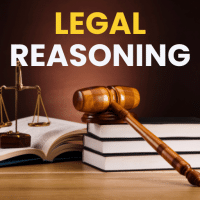CLAT Exam > CLAT Questions > What is the maximum value of deforming force ...
Start Learning for Free
What is the maximum value of deforming force up to which a material shows elastic property and above which the material loses it?
- a)Elasticity
- b)Strain
- c)Elastic Limit
- d)Stress
Correct answer is option 'C'. Can you explain this answer?
Most Upvoted Answer
What is the maximum value of deforming force up to which a material sh...
Understanding Elastic Limit
The elastic limit is a critical concept in materials science and mechanics, defining the threshold up to which a material can deform elastically. Beyond this limit, the material will not return to its original shape when the deforming force is removed.
Key Points about Elastic Limit:
- Definition: The elastic limit refers to the maximum stress or deforming force that a material can withstand while still returning to its original shape after the load is removed.
- Elastic Deformation: Within the elastic limit, materials exhibit elastic deformation, where they can stretch or compress without permanent changes in their structure.
- Plastic Deformation: Once the applied force exceeds the elastic limit, the material undergoes plastic deformation, meaning it will not return to its original shape, resulting in permanent changes.
Importance of Elastic Limit:
- Material Selection: Understanding the elastic limit is crucial for engineers and designers to select appropriate materials for specific applications, ensuring they can withstand loads without permanent deformation.
- Safety and Performance: Knowing the elastic limit helps in assessing the safety and performance of structures and components, preventing failure due to excessive stress.
Real-World Applications:
- Construction: In buildings and bridges, materials must be chosen based on their elastic limits to ensure they can support expected loads without undergoing irreversible deformation.
- Mechanical Components: Springs and other mechanical parts rely on their elastic properties, making it essential to operate within their elastic limits for effective functionality.
In summary, the elastic limit is the maximum force or stress a material can endure while retaining its elastic properties. Understanding this concept is vital for effective engineering and material science practices.
The elastic limit is a critical concept in materials science and mechanics, defining the threshold up to which a material can deform elastically. Beyond this limit, the material will not return to its original shape when the deforming force is removed.
Key Points about Elastic Limit:
- Definition: The elastic limit refers to the maximum stress or deforming force that a material can withstand while still returning to its original shape after the load is removed.
- Elastic Deformation: Within the elastic limit, materials exhibit elastic deformation, where they can stretch or compress without permanent changes in their structure.
- Plastic Deformation: Once the applied force exceeds the elastic limit, the material undergoes plastic deformation, meaning it will not return to its original shape, resulting in permanent changes.
Importance of Elastic Limit:
- Material Selection: Understanding the elastic limit is crucial for engineers and designers to select appropriate materials for specific applications, ensuring they can withstand loads without permanent deformation.
- Safety and Performance: Knowing the elastic limit helps in assessing the safety and performance of structures and components, preventing failure due to excessive stress.
Real-World Applications:
- Construction: In buildings and bridges, materials must be chosen based on their elastic limits to ensure they can support expected loads without undergoing irreversible deformation.
- Mechanical Components: Springs and other mechanical parts rely on their elastic properties, making it essential to operate within their elastic limits for effective functionality.
In summary, the elastic limit is the maximum force or stress a material can endure while retaining its elastic properties. Understanding this concept is vital for effective engineering and material science practices.
Free Test
FREE
| Start Free Test |
Community Answer
What is the maximum value of deforming force up to which a material sh...
The Maximum Extent to which a solid may be stretched without permanent alteration of size or shape.

|
Explore Courses for CLAT exam
|

|
Similar CLAT Doubts
Question Description
What is the maximum value of deforming force up to which a material shows elastic property and above which the material loses it?a)Elasticityb)Strainc)Elastic Limitd)StressCorrect answer is option 'C'. Can you explain this answer? for CLAT 2025 is part of CLAT preparation. The Question and answers have been prepared according to the CLAT exam syllabus. Information about What is the maximum value of deforming force up to which a material shows elastic property and above which the material loses it?a)Elasticityb)Strainc)Elastic Limitd)StressCorrect answer is option 'C'. Can you explain this answer? covers all topics & solutions for CLAT 2025 Exam. Find important definitions, questions, meanings, examples, exercises and tests below for What is the maximum value of deforming force up to which a material shows elastic property and above which the material loses it?a)Elasticityb)Strainc)Elastic Limitd)StressCorrect answer is option 'C'. Can you explain this answer?.
What is the maximum value of deforming force up to which a material shows elastic property and above which the material loses it?a)Elasticityb)Strainc)Elastic Limitd)StressCorrect answer is option 'C'. Can you explain this answer? for CLAT 2025 is part of CLAT preparation. The Question and answers have been prepared according to the CLAT exam syllabus. Information about What is the maximum value of deforming force up to which a material shows elastic property and above which the material loses it?a)Elasticityb)Strainc)Elastic Limitd)StressCorrect answer is option 'C'. Can you explain this answer? covers all topics & solutions for CLAT 2025 Exam. Find important definitions, questions, meanings, examples, exercises and tests below for What is the maximum value of deforming force up to which a material shows elastic property and above which the material loses it?a)Elasticityb)Strainc)Elastic Limitd)StressCorrect answer is option 'C'. Can you explain this answer?.
Solutions for What is the maximum value of deforming force up to which a material shows elastic property and above which the material loses it?a)Elasticityb)Strainc)Elastic Limitd)StressCorrect answer is option 'C'. Can you explain this answer? in English & in Hindi are available as part of our courses for CLAT.
Download more important topics, notes, lectures and mock test series for CLAT Exam by signing up for free.
Here you can find the meaning of What is the maximum value of deforming force up to which a material shows elastic property and above which the material loses it?a)Elasticityb)Strainc)Elastic Limitd)StressCorrect answer is option 'C'. Can you explain this answer? defined & explained in the simplest way possible. Besides giving the explanation of
What is the maximum value of deforming force up to which a material shows elastic property and above which the material loses it?a)Elasticityb)Strainc)Elastic Limitd)StressCorrect answer is option 'C'. Can you explain this answer?, a detailed solution for What is the maximum value of deforming force up to which a material shows elastic property and above which the material loses it?a)Elasticityb)Strainc)Elastic Limitd)StressCorrect answer is option 'C'. Can you explain this answer? has been provided alongside types of What is the maximum value of deforming force up to which a material shows elastic property and above which the material loses it?a)Elasticityb)Strainc)Elastic Limitd)StressCorrect answer is option 'C'. Can you explain this answer? theory, EduRev gives you an
ample number of questions to practice What is the maximum value of deforming force up to which a material shows elastic property and above which the material loses it?a)Elasticityb)Strainc)Elastic Limitd)StressCorrect answer is option 'C'. Can you explain this answer? tests, examples and also practice CLAT tests.

|
Explore Courses for CLAT exam
|

|
Signup to solve all Doubts
Signup to see your scores go up within 7 days! Learn & Practice with 1000+ FREE Notes, Videos & Tests.





























